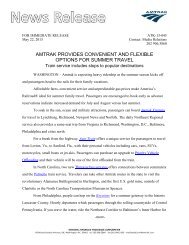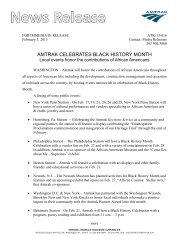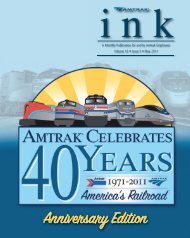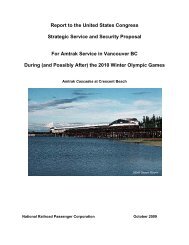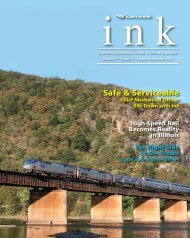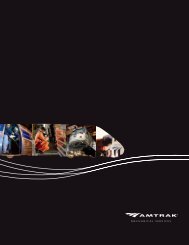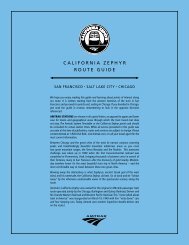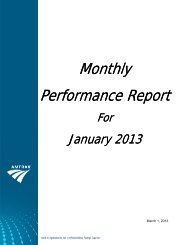Statement of Joseph H. Boardman, President and CEO - Amtrak
Statement of Joseph H. Boardman, President and CEO - Amtrak
Statement of Joseph H. Boardman, President and CEO - Amtrak
You also want an ePaper? Increase the reach of your titles
YUMPU automatically turns print PDFs into web optimized ePapers that Google loves.
TESTIMONY<br />
OF<br />
JOSEPH H. BOARDMAN<br />
PRESIDENT AND CHIEF EXECUTIVE OFFICER<br />
AMTRAK<br />
60 MASSACHUSETTS AVENUE, NE<br />
WASHINGTON, DC 20002<br />
(202) 906-3960<br />
BEFORE THE<br />
COMMITTEE TRANSPORTATION & INFRASTRUCTURE<br />
OVERSIGHT HEARING ON<br />
“A REVIEW OF AMTRAK OPERATIONS PART 2:<br />
THE HIGH COST OF AMTRAK’S<br />
MONOPOLY MENTALITY IN COMMUTER RAIL<br />
COMPETITIONS”<br />
TUESDAY, SEPTEMBER 11, 2012<br />
10:00 A.M.<br />
2167 RAYBURN HOUSE OFFICE BUILDING
Mr. Chairman, Ranking member, <strong>and</strong> members <strong>of</strong> the Committee, good morning.<br />
<strong>Amtrak</strong> has been involved in the commuter rail business since the early days <strong>of</strong> our<br />
company. When we acquired the Northeast Corridor in 1976, we became responsible for<br />
dispatching <strong>and</strong> maintaining the tracks used by hundreds <strong>of</strong> commuter trains each day, most <strong>of</strong><br />
which were then operated by Conrail. In the Northeast Rail Services Act <strong>of</strong> 1981, Congress<br />
relieved Conrail <strong>of</strong> its obligation to provide commuter service <strong>and</strong> stated that <strong>Amtrak</strong> should be<br />
available to operate commuter trains for commuter authorities that chose not to provide their own<br />
operations. We began operating what is now MARC’s Penn Line between Washington <strong>and</strong><br />
Baltimore on January 1, 1983. During the 29 years we’ve operated that service, it has grown<br />
from 4 to 57 weekday trains. <strong>Amtrak</strong> has also operated a number <strong>of</strong> other commuter services. In<br />
some cases, we have since helped to inaugurate new services. In others, we became involved in<br />
commuter services as a contract carrier for agencies that needed to find a capable replacement<br />
for freight carriers who wished to exit the commuter business, or were dissatisfied with their<br />
current operator. Currently, we operate 3 commuter services: the MARC Penn Line in<br />
Maryl<strong>and</strong>, the Shore Line East in Connecticut, <strong>and</strong> Metrolink in Los Angeles. We maintain<br />
equipment for the Sounder service in Seattle <strong>and</strong> we dispatch South Florida’s Tri-Rail. We also<br />
provide access, dispatching, equipment maintenance <strong>and</strong>/or other services for Long Isl<strong>and</strong><br />
Railroad, New Jersey Transit, Metra in Chicago, <strong>and</strong> Boston’s MBTA, among others.<br />
The American Public Transit Association lists 26 commuter carriers in America. Of<br />
those, eight operate their own commuter rail services; the remainder contract with another carrier<br />
to provide them. The largest commuter carriers are typically run as integrated railroads,<br />
maintaining <strong>and</strong> operating their own track <strong>and</strong> trains. Several <strong>of</strong> the next largest services are run<br />
by the railroads whose tracks they use – so Metra contracts with BNSF <strong>and</strong> UP to operate<br />
1
services on their routes. On a slightly smaller scale, <strong>Amtrak</strong> runs the MARC NEC service while<br />
CSX currently operates the MARC trains on their Camden <strong>and</strong> Brunswick Lines. <strong>Amtrak</strong><br />
operates the CDOT Shore Line East trains that use our Northeast Corridor. The remainder <strong>of</strong> the<br />
agencies contract with independent carriers to run their services. Those carriers <strong>and</strong> the freights<br />
have the vast majority <strong>of</strong> the U.S. commuter rail business. <strong>Amtrak</strong>-operated services generate<br />
fewer than 6% <strong>of</strong> the nation’s annual commuter passenger-miles.<br />
From <strong>Amtrak</strong>’s point <strong>of</strong> view, the contract commuter business has both costs <strong>and</strong><br />
benefits. It can generate net revenue, which allows us to reduce our dependence on Federal<br />
operating support. Because we do not use Federal funds to cross-subsidize these agencies, our<br />
bids can be more expensive than those <strong>of</strong> private companies that may underbid to enter the<br />
market or to build a market for other services such as capital replacement. Whatever the cause,<br />
pr<strong>of</strong>it margins have decreased significantly in recent years.<br />
Liability is also a major challenge. As you know, while <strong>Amtrak</strong> must maintain $200<br />
million in liability insurance, other commuter operators are not subject to this requirement.<br />
When we take on a service, we must ensure that we don’t take on a liability obligation that could<br />
leave us vulnerable to a judgment or an award that could impact our financial viability. There<br />
are a lot <strong>of</strong> companies competing for the commuter business, <strong>and</strong> we are finding that agencies<br />
are increasingly asking them to take on much greater liability exposure in the event <strong>of</strong> an<br />
accident rather than having the agency purchase its own insurance to cover the risk. <strong>Amtrak</strong><br />
cannot assume that risk. When responsibility for liability exposure is passed to a private<br />
commuter service operator that does not have adequate insurance, <strong>and</strong> can be constructed so that<br />
it can escape an unaffordable liability judgment through bankruptcy, the risk is in effect<br />
transferred to the riding public. If <strong>Amtrak</strong> assumes that liability, then the costs generated by a<br />
2
single commuter operation are transferred to the federal taxpayer, an option we do not believe is<br />
in our best interest.<br />
Over the past two years, we have lost two operations, VRE <strong>and</strong> Caltrain, <strong>and</strong> gained a<br />
third – Metrolink in Los Angeles, which asked us to take over its rail operations in the wake <strong>of</strong><br />
the Chatsworth collision. <strong>Amtrak</strong> will remain in the commuter rail business, <strong>and</strong> we are taking<br />
some <strong>of</strong> the lessons learned from recent events into account. We will continue to work with<br />
agencies that are a “good fit” for both <strong>Amtrak</strong> <strong>and</strong> the agency. This is an exciting field right<br />
now, <strong>and</strong> there is plenty <strong>of</strong> competition <strong>and</strong> many opportunities for both carriers <strong>and</strong> agencies to<br />
find suitable partners. <strong>Amtrak</strong> will continue to look at the opportunities on a case-by-case basis,<br />
<strong>and</strong> we will be guided by the need to provide our partners with the support they’re looking for<br />
<strong>and</strong> our need to generate revenues that can be used to reduce <strong>Amtrak</strong>’s dependence on Federal<br />
operating support.<br />
3



